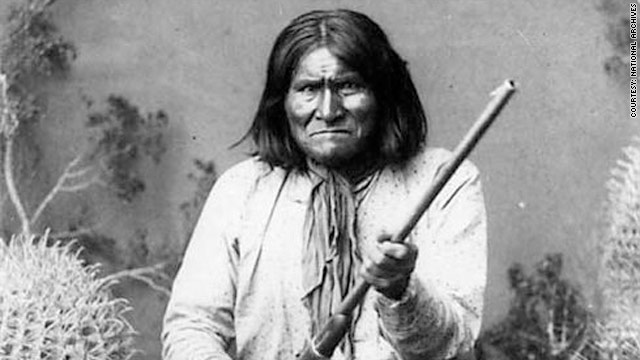by Alysa Landry
On Sept. 4, 1886, the great Apache warrior Geronimo surrendered in Skeleton Canyon, Arizona, after fighting for his homeland for almost 30 years. He was the last American Indian warrior to formally surrender to the United States.
Born in June 1829 near the Gila River in Arizona, Geronimo was a mild-mannered youth, said Mark Megehee, museum specialist at the Fort Sill Museum in Oklahoma. His birth name was Goyalkla or “One Who Yawns.”
At age 17, Geronimo married Alope, with whom he had three children. His life changed in 1858 when a company of Mexican soldiers led by Colonel Jose Maria Carrasco attacked the Apaches and murdered Geronimo’s wife, mother and children.
“Carrasco said he struck and meant to rub out every man, woman and child of the Apaches, but the warriors by and large escaped while their families were the ones that were slaughtered,” said Megehee, a member of the Sac and Fox Nation of Oklahoma. “That changed the personality of Geronimo. His friends noticed he was no longer mild and pleasant to deal with. He was unexpectedly violent and had a temper. He became very grieving, but he was going to settle the score.”
In his own words, translated in 1909 and published in the 1996 book Geronimo: His Own Story, Geronimo described the incident.
“I found that my aged mother, my young wife, and my three small children were among the slain,” he said. “There were no lights in camp, so without being noticed I silently turned away and stood by the river. How long I stood there I do not know, but when I saw the warriors arranging for a council I took my place.”
Only 80 warriors remained, so the chief directed survivors to return home to Arizona, Geronimo said. He had “no purpose left” because he “had lost all.”
“I was never again contented in our quiet home,” he wrote. “I had vowed vengeance upon the Mexican troopers who had wronged me, and whenever I came near (my father’s) grave or saw anything to remind me of former happy days my heart would ache for revenge upon Mexico.”
Geronimo went on to lead a band of Apache warriors throughout southern Arizona and New Mexico, successfully keeping white settlers off Apache lands for decades and becoming a “symbol of the untamed freedom of the American West.”
“He was not just a tough guy, but he had leadership abilities,” Megehee said. “He looked out for men, women and children in a way that all their needs were met. Geronimo did more with less. In today’s vocabulary, he multiplied his force by stealth, by firepower and by mobility.”
By 1886, however, Geronimo was tired. After leading 39 Apaches across the Southwest, running as much as 80 miles per day to stay ahead of 5,000 white soldiers, Geronimo surrendered to General Nelson A. Miles on September 4.
Miles, in his memoirs, described Geronimo as “one of the brightest, most resolute, determined-looking men I have ever encountered.”
After his trial, Geronimo was put to work as a prisoner of war, doing heavy labor for the South Pacific Railroad. This was in violation of the agreement he made with the U.S. when he surrendered.
He spent the rest of his life as a prisoner of war and a scout for the U.S. Army, though he gained popularity as an attraction at the St. Louis World’s Fair and Wild West shows. He also was one of six Indians to march in the 1905 inaugural parade for President Theodore Roosevelt.
He died at Fort Sill, Oklahoma, in 1909, still on the federal payroll as a scout.
Read more at http://indiancountrytodaymedianetwork.com/2013/09/04/native-history-geronimo-last-native-warrior-surrender-151136



